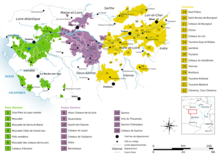Saint-Nicolas-de-Bourgueil AOC
[3][4] These wines are renowned for being fruity, similar to those of the neighboring Bourgueil AOC, and well suited for pairing with a wide variety of dishes.
Though long overshadowed by the neighboring communes of Bourgueil and Chinon across the Loire, the area earned a reputation for the quality of its red wine as early as the Middle Ages.
[8] The river Vienne reaches the Loire at Candes-Saint-Martin across from the AOC creating a large body of water with a resulting lake effect that tempers the climate.
Centered on the commune of Saint-Nicolas-de-Bourgueil, the vineyard soils of the AOC are not much different than the greater Bourgueil region with the exception of a slightly higher sand/limestone content (known locally as varennes).
Both grapes are late-ripening varieties that require a long growing season ideally ending with an Indian summer in order to achieve full ripeness.
[1] After harvest the grapes are destemmed and crushed with a short maceration period, often with the must warmed up to aid in extraction of color and phenolics before the wines are pressed and put into barrel.
[9] For wines to be labelled under the Saint-Nicolas-de-Bourgueil AOC designation, the grapes must be limited to a harvest yield no greater than 55 hl/ha (approximately 3 tons/acre).




